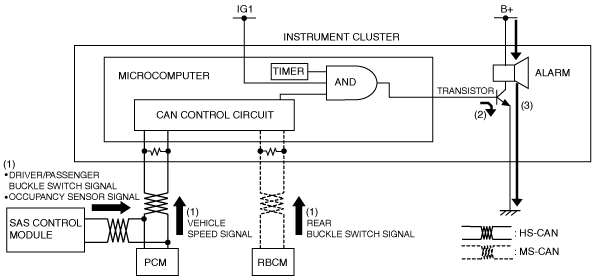SEAT BELT WARNING ALARM
id092200019600
Purpose
• The seat belt warning alarm warns occupants that a seat belt is not fastened.
Function
• The instrument cluster sounds the seat belt warning alarm based on the following CAN signals:
-
― Vehicle speed signal sent from PCM
― Driver/passenger buckle switch signal, occupancy sensor signal sent from SAS control module
― Rear seat buckle switch signal sent from rear body control module (RBCM)
Driver/Passenger seat belt warning alarm sound function
-
• The driver/passenger seat belt warning alarm has an initial warning and subsequent warning.
Initial warning
-
• When all of the following conditions are met, the alarm sounds.
-
― Vehicle speed is approx. 20 km/h {12 mph} or more
― Driver/passenger buckle switch on signal (seat belt unfastened) is detected
― Occupancy sensor on signal (occupant in passenger seat) is detected (passenger seat belt warning alarm only)
• The driver/passenger seat belt warning alarm sound pattern is as shown in the figure.
Subsequent warning
-
• When all of the following conditions are met, the alarm sounds.
-
― Vehicle speed is approx. 20 km/h {12 mph} or more
― Occupancy sensor on signal (occupant in passenger seat) detected (passenger seat belt warning alarm only)
― After initial warning, buckle switch off signal (seat belt fastened) to on signal (seat belt unfastened) is detected
• The driver/passenger seat belt warning alarm sound pattern is as shown in the figure.
Rear seat belt warning alarm sound function (with rear seat belt warning alarm)
-
• When all of the following conditions are met, the alarm sounds.
-
― Ignition switch ON (engine off or on)
― Rear seat buckle switch off signal (seat belt fastened) to on signal (seat belt unfastened) is detected
• The rear seat belt warning alarm sound pattern is as shown in the figure.
Construction
• The seat belt warning alarm sounds using the buzzer built into the instrument cluster.
Operation
1. The instrument cluster receives (1) the vehicle speed signal from the PCM, the driver/passenger buckle switch signal and occupancy sensor signal from the SAS control module, and the rear seat buckle switch signal from the rear body control module (RBCM) when the ignition is switched ON (engine off or on).
2. The instrument cluster microcomputer turns the transistor on (2) based on each signal.
3. When the transistor turns on, a ground circuit with the alarm is established and the alarm sounds (3).
Fail-safe
• Function not equipped.
 ac5wzn00000932
ac5wzn00000932 ac5wzn00000933
ac5wzn00000933
